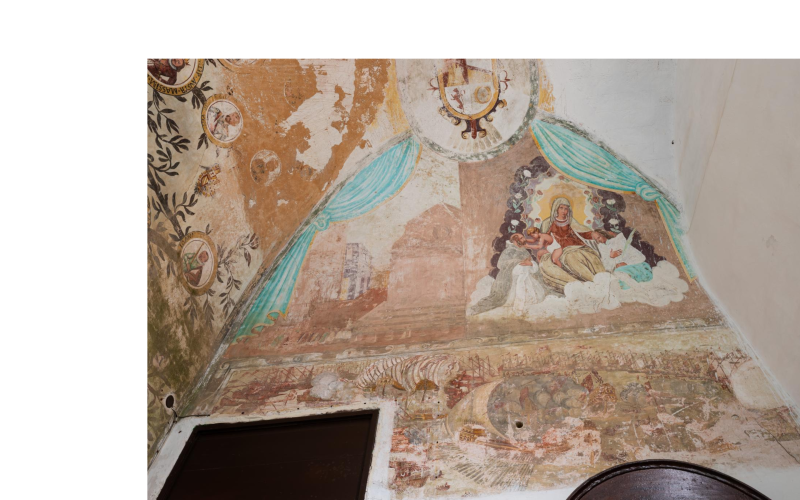The Virgin of the Rose and the battle of Lepanto in Gallipoli
Anonymous, Virgin of the Rose (and other frescoes), after 1571. Fresco. Church of San Domenico al Rosario, Gallipoli. Photograph by Gabriel Rodriguez © The Trustees of Columbia University, Media Center for Art History, Department of Art History & Archaeology.
At the entrance to the cloister of the Dominican convent of Gallipoli, a fresco depicts the genealogical tree of the Aragonese and Habsburg royal families (Fig. 1). On the lower branches of the tree are several members of the family of the founder of the Dominican Order, Dominic de Guzmán. Next to the tree, on the adjacent wall, we see a rolled green curtain that opens onto a representation of the Virgin of the Rose (or Virgin of the Rosary) on the right and, on the left, a procession in front of the Constantinian Basilica of St. Peter’s in Rome. Below these two scenes, we see one of the most common representations of the Battle of Lepanto: the clash between La Capitana, led by Don Juan de Austria, and the Ottoman ship of Ali Pasha, each followed by their respective fleets.
The mural painting is severely deteriorated, making it difficult to identify and interpret some of its elements. However, what remains visible testifies to the link between the influential Spanish presence in Gallipoli and the establishment of the iconography of the Virgin of the Rosary as an intercessor in favor of the Holy League, which, despite its numerical disadvantage, defeated the Ottomans.
The paintings—or at least the one referring to Lepanto—must have been made after the battle, between the end of 1571 and the following years, when this Marian iconography became established (Pindinelli 2021). In fact, the Virgin's intercession was retrospectively decisive in explaining the Christian triumph over the superior Ottoman forces at Lepanto. Pius V, the tireless promoter of the Holy League, is said to have known of the Christian triumph in the naval battle before the news could reach Rome, thanks to a vision he had had of the Virgin. Therefore, he decreed that the day of the naval engagement, October 7, should be commemorated as the day of Our Lady of Victory. His successor, Gregory XIII, however, decreed in 1573 that the day should be dedicated to the Virgin of the Rosary, thus merging her iconography with that of the Virgin of Victory. Before then, the iconographic representation of the intercession of the Virgin had ranged from the Virgin of Victory to the Virgin of Milk to the Virgin of the Rose. For this reason, when studying the devotion to the Virgin of the Rosary and her representations in relation to the Battle of Lepanto, iconographic elements from one devotion can appear in another, all connected by the battle of 1571. This is exactly what happens in the Dominican convent of Gallipoli.
In this painting, we see the Virgin surrounded by roses and holding the Christ Child in her hands. It has been named the "Virgin of the Rose," although the "Virgin of the Rosary" is the common iconographic designation for this type of composition, as we can see in the Fifteen Mysteries and the Virgin of the Rosary (ca. 1515), attributed to Goswijn van der Weyden. At first glance, the Gallipoli composition, in which the seated Virgin holds the Child on her lap accompanied by a kneeling St. Dominic, seems to correspond to the more widespread iconography of the Virgin of the Rosary. However, there is no rosary here, and while the roses certainly refer to the mysteries, they could have been painted later, as the fresco shows signs of subsequent interventions.
Generally speaking, the iconography of Our Lady of the Rosary can be divided into two schemes. In one, the Virgin and Child offer rosaries to St. Dominic and other Dominican saints (most often St. Catherine of Siena or St. Rosa of Lima, although there are many variations); in this case, the main purpose is to attest to the Order's affiliation and promotion of this devotion. In the other scheme, the Virgin is surrounded by civil and ecclesiastical authorities, as in Dürer's Feast of the Garlands of Roses (1506), where the Virgin and Child crown Pope Julius II and the Holy Roman Emperor Maximilian I. According to Victor Minguez (2022), Dürer's painting established a fundamental link between the Order and the imperial family. The Habsburg`s ties to the Dominican order would be eventually strengthened by Philip II, as subsequent forms of this iconography attest. As a result, the depiction of Our Lady of the Rosary in the company of the monarch and the pope would become a feature of southern Italian “Lepantine” iconography. For example, depictions of the Virgin accompanied by Pius V (canonized in the eighteenth century) and Philip II can be seen in the churches of San Giuseppe Patriaca, Nardò (Fig. 2), and Santa Maria della Mercede a Montecalvario, Naples (Minguez 2022). There are variations of this iconography, such as the one in the Basilica of Santa Maria della Vittoria, San Vito dei Normani, where the Virgin holds a palm with the Pope and the King at her feet (Fig. 3).
In Gallipoli, we find a mix of the two schemes. Kneeling at the Virgin’s feet is Don Juan de Austria, son of Charles V and commander of the Holy League. According to Pindinelli (2016), he is recognizable by his armor, sword, and triumphal palm, which alludes to the events in Lepanto (depicted below). The association between the palm and Don Juan de Austria is common; it can be seen, for example, in the painting of the Virgin of Victory in the eponymous Neapolitan church, which was built to commemorate both Don Juan’s triumph and the Virgin’s intercession. In it, we see Pius V and Don Juan de Austria, who kneeling before the Virgin, carry that very same palm, signifying that the naval success at Lepanto is ultimately due to her (Fig. 4).
As Minguez points out, this early iconography of the Virgin of Victory resulted from a vision of King Ferdinand the Catholic during the siege of Malaga in 1487. It was later associated with the Spanish crown and its support for the Catholic fight against heresy. Therefore, we can observe an iconographic change in the churches of Apulia and in the Reino de Napoles as a whole: the iconography of Our Lady of Victory, holding either a palm or a sword, was replaced by that of Our Lady of the Rosary. As a result, many confraternities of veterans of Lepanto were founded around her devotion, which was very popular among military confraternities in Spain in the sixteenth century (Minguez 2022).
Minguez identifies the Virgin of the Rosary and the Inmaculada as the two main Marian devotions associated with the Spanish monarchy. According to him, the association of the former with the Habsburgs was successful in the sixteenth century but lost popularity in the following centuries. This is an important point. In 1536, the miraculous appearance of the Virgin in the conflict between the Spanish invaders and the Incas in Cuzco was believed to have ensured the victory of the Christian troops and the conversion of their infidel opponents. Following the example of Lepanto, the Dominican friar Juan Mendelez, in his chronicle of the province of Peru titled Verdaderos Tesoros de las Yndias (1681), attributed the Christian triumph not to the Virgin of Victory, as others had done, but to the Virgin of the Rosary. But this substitution had only limited success. The few paintings and the one drawing by Guama Poma de Ayala depicting the miracle are closer to the iconography of the Inmaculada (Fig. 5; Fig. 6). This preference indicates how imperial uses of the Rosary Virgin changed over time toward devotion to the Inmaculada.
March 6, 2023
Bibliography
Bremond, Antonino. De Guzmana Stirpe S. Dominici Fundatoris Familiae Fratrum Praedicatorum Historica Demostratio. Roma: 1740.
Cummins, Thomas, and Gabriela Ramos, eds. Los incas, reyes del Perú. Lima: Banco de Credito, 2005.
Dandelet, Thomas James. "Paying for the new St. Peter’s: Contributions to the construction of the new basilica from Spanish lands, 1506- 1620." In Spain in Italy. Politics, Society and Religion 1500-1700, edited by Thomas James Dandelet and John A. Marino, 181–195. Leiden-Boston: Brill, 2007.
Gelao, Clara. Confraternite. Arte e devozione in Puglia dal quattrocento al settecento. Napoli: Electa, 1994.
Gisbert, Teresa. Iconografía y mitos indígenas en el arte. La Paz: Editorial GIsbert, 1994.
Iglesias, Lucila. “La Virgen María como celestial aurora que venció y salvó a los incas”. In Latin American and Latinx Visual Culture 3, no. 3 (2021): 115–123.
Melendez, Juan. Verdaderos Tesoros de las Yndias en la historia de la gran provincia de San Juan Bautista del Peru. Roma: Nicolas Angel Tinassio, 1681
Minguez Cornelles, Victor. "Pietas Austriaca y política mariana : del Rosario a la Inmaculada." In La Vergine contesa: Roma, l'Immacolata Concezione e l'universalismo della monarchia cattolica (secc. XVII-XIX), edited by Manfredi Merluzzi, Gaetano Sabatini, and Flavia Tudini, 105–121. Roma: Viella, 2022.
Pindinelli, Elio. "L'affresco della battaglia di Lepanto ai Domenicani di Gallipoli: dai Gusman a don Giovanni d'Austria." In Il Rosario della gloriosa Vergine, edited by Eugenio Bruno and Mario Spedicato, 127–138. Lecce: Edizioni Grigo, 2016.
Pindinelli, Elio. “Domenicani a Gallipoli.” Interview by T.T. Salento. November, 2021.
Schütze, Sebastian. "The Politics of Counter-Reformation Iconography and a Quest for the Spanishness of Neapolitan Art." In Spain in Italy. Politics, society and religion 1500-1700, edited by Thomas James Dandelet and John A. Marino, 555–568. Leiden-Boston: Brill, 2007.
Tassolo, Domenico, and Baldasare Mariotti. I trionfi, feste et livree fatti dalli signore conservatore, & popolo romano, & da tute le arti di Roma, nella felicissima & honorata entrata dell Illustrissimo signor Marcantonio Colonna. Venetia: 1571.


